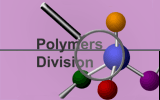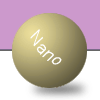| |
Structure-Property Relationships in Dental Polymers and
Composites
|
| |
Introduction
|
 |
 |
Polymeric dental resins and
composites are finding increasing applications in dentistry
and allied biomedical fields. As part of a joint research
effort supported by the National Institute of Dental and
Craniofacial Research and also in collaboration with the
American Dental Association Health Foundation Paffenbarger
Research Center, NIST is providing the dental industry
with a fundamental knowledge base that will aid in the
development of novel materials and the prediction of their
clinical performance.
|
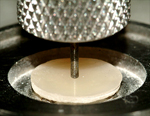 |
| Photopolymerizable dental composite paste
|
Biaxial flexural test for
determining composite strength |
|
| |
Objective
|
 |
| To develop and characterize novel dental resins and composites
that exhibit high conversion, low shrinkage, strong mechanical
properties and enhanced durability.
|
| |
NIST Role
|
 |
| |
Assist the dental community in the design,
synthesis and development of biostable and bioactive dental
composites with optimal critical properties
Develop model resin, composite and initiator systems
Help design and develop efficient, accurate and reproducible
measurement techniques to characterize dental materials
Help predict the clinical performance of dental materials
Establish structure-property relationships for polymeric
dental materials |
 |
| MALDI-TOF spectrum
of an ethoxylated bisphenol-A dimethacrylate dental monomer
from Esstech (Essington, PA) |
|
| |
Highlights
|
 |
| |

Volumetric
shrinkage as a function of organogelator concentration
|
MALDI-TOF as a characterization tool
for molecular weight determination of dental monomers
Synthesis and evaluation of remineralizing
composites containing amorphous calcium phosphate
Reduced volumetric shrinkage of dental
composites through the addition of an organogelator
Improved interfacial bonding in dental
composites through dual-silanization techniques
|
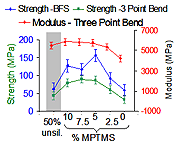 Mechanical properties of composites containing dual silanized
silica nanoparticles
Mechanical properties of composites containing dual silanized
silica nanoparticles |
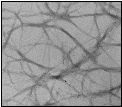
Organogel
network |
 |

Organogelator
|
 |
|
| |
Customers, Collaborators and Impact
|
 |
Three invited talks at the American Chemical Society symposium
on dental materials
Collaborations with Food and Drug Administration and American
Dental Association Foundation
Technology transfer: U.S. Patent 5,508,342 (1996)
J. Antonucci, D. Skrtic, D. Eanes: Polymeric amorphous calcium
phosphate compositions. H.J. Bosworth and Co. now has sublicense
|



|

 |
| |
NIST Contributors:
|
 |
Joseph M. Antonucci
Sheng Lin-Gibson
Elizabeth A. Wilder
Sidi Bencherif
Newell R. Washburn
Kristen S. Wilson
Da-Wei Liu
Kai Zhang
|
| |
| |
Collaborators:
|
 |
Drago Skrtic
Janet B. Quinn
Anthony A. Giuseppetti
Mahnaz Farahani
William Regnault
Sabine H. Dickens
 |
| |
| |
| |
| |
| |
| |


